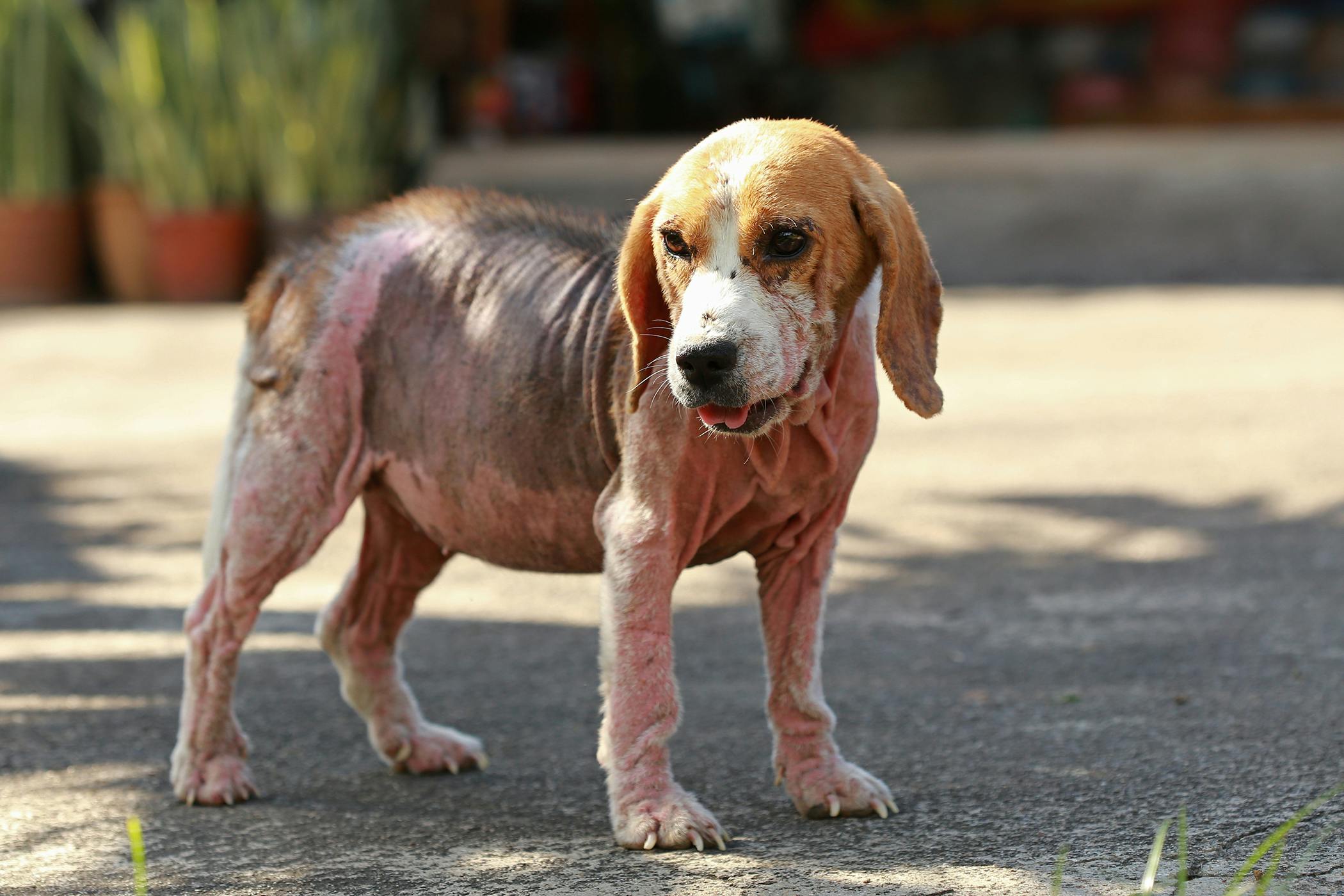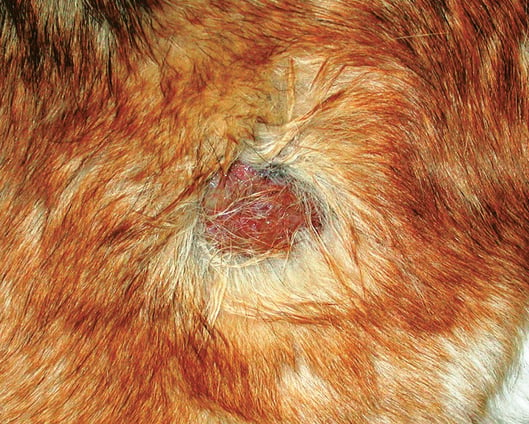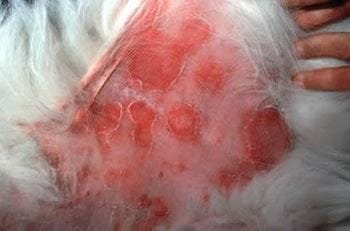Pyoderma in dogs is a bacterial skin infection that requires topical treatment, such as medicated sprays and shampoos, containing benzoyl peroxide, sulfur with salicylic acid, or chlorhexidine. These treatments should be used once or twice per week for three to four weeks, along with clean, dry, padded bedding for the dog.
Pyoderma does not go away on its own, as it is caused by bacteria that can continue to multiply if not eliminated. Antibiotics and antibacterial topical medication are necessary to eliminate the bacteria. Pyoderma is not contagious to other dogs or humans, as something typically damages the skin barrier to allow the bacteria to invade.

Credit: wagwalking.com
Introduction To Pyoderma In Dogs
Pyoderma is a common bacterial infection that affects the skin of dogs. Also known as impetigo, especially in puppies, pyoderma is characterized by redness, irritation, and the formation of pus-filled lesions on the skin. If left untreated, pyoderma can cause discomfort for dogs and may lead to more serious complications.
Definition Of Pyoderma
Pyoderma is defined as a bacterial skin infection that affects dogs. It is commonly caused by bacterial colonization or invasion of the skin, particularly by coagulase-positive staphylococci, such as Staphylococcus intermedius. In some cases, secondary bacterial invaders like Pseudomonas spp., Proteus spp., and Escherichia coli may also be present, especially in chronic, recurrent, or deep pyoderma cases.
Causes Of Pyoderma
The primary cause of pyoderma in dogs is the disruption or damage to the skin barrier, which allows bacteria to invade and multiply. This can occur due to various factors, such as:
- Continuous moisture or wetness on the skin
- Excessive skin folds or wrinkles
- Parasite infestation, such as fleas or mites
- Allergies or allergic reactions
- Autoimmune disorders
- Trauma or injury to the skin
These factors create an ideal environment for bacterial growth and proliferation, leading to the development of pyoderma.
Contagiousness Of Pyoderma
Pyoderma is caused by bacteria and is not typically contagious to other dogs or humans. The presence of bacterial infection indicates a compromised skin barrier, which opens the door for bacterial invasion. However, it is important to note that something must usually damage the skin barrier to allow the bacteria to enter. Therefore, the risk of spreading pyoderma to other pets or humans in the household is minimal.
It is still important to practice good hygiene and take necessary precautions when dealing with a dog with pyoderma by regularly washing hands and cleaning affected areas. Seek veterinary care for proper diagnosis and treatment to prevent the infection from worsening or spreading.

Credit: insights.nextmune.com
Diagnosing And Treating Pyoderma In Dogs
Pyoderma is a common bacterial skin infection that affects dogs. It can cause discomfort and irritation for your furry friend, but with proper diagnosis and treatment, it can be effectively managed. In this article, we will explore the signs and symptoms of pyoderma, how it is diagnosed, and the various treatment options available.
Signs And Symptoms Of Pyoderma
Recognizing the signs and symptoms of pyoderma is crucial in early detection and effective treatment. Some common signs to look out for include:
- Red, inflamed skin
- Pustules or pimples
- Itchy or irritated areas
- Crusty or scaly skin
- Unpleasant odor
- Hair loss in affected areas
If you notice any of these symptoms in your dog, it is important to consult with a veterinarian for a proper diagnosis.
Diagnosis Of Pyoderma
Diagnosing pyoderma usually involves a thorough examination of your dog’s skin and a review of their medical history. The veterinarian may also perform tests such as skin scrapings or bacterial cultures to identify the specific bacteria causing the infection. These steps help determine the severity of the infection and guide the appropriate treatment plan.
Treatment Options For Pyoderma
There are several treatment options available for pyoderma, depending on the severity of the infection. Some common treatment options include:
- Topical treatments: This involves the use of sprays and medicated shampoos that contain ingredients like benzoyl peroxide, sulfur with salicylic acid, or chlorhexidine. These products are applied directly to the affected areas and may need to be used once or twice per week for three to four weeks.
- Systemic antibiotics: In more severe cases, oral antibiotics may be prescribed to fight the bacterial infection from within. It is important to follow the prescribed dosage and complete the full course of treatment to ensure effective eradication of the bacteria.
- Management of underlying conditions: Sometimes, pyoderma can be a result of underlying factors such as allergies or hormonal imbalances. Treating these underlying conditions can help prevent recurrence of the infection.
It is crucial to follow your veterinarian’s advice and treatment plan for the best results. Additionally, maintaining good hygiene practices, such as regular bathing and keeping your dog’s bedding clean and dry, can help prevent future infections.
By recognizing the signs and symptoms, seeking timely diagnosis, and following the recommended treatment, you can help your dog overcome pyoderma and ensure their skin stays healthy and comfortable.
Preventing And Managing Pyoderma In Dogs
Pyoderma is a common bacterial skin infection in dogs that can cause discomfort and distress. However, with the right preventative measures and proper management, you can help keep your furry friend’s skin healthy and pyoderma-free. In this article, we will discuss some effective strategies to prevent pyoderma and provide tips on how to manage it if it occurs.
Preventative Measures For Pyoderma
Preventing pyoderma in dogs involves maintaining good overall health and taking proactive steps to keep the skin clean and free from infection. Here are some preventative measures you can take:
- Regular bathing: Bathing your dog regularly with a gentle, veterinary-recommended shampoo can help keep the skin clean and prevent the buildup of bacteria.
- Proper grooming: Regularly brushing your dog’s coat helps remove dead hair and prevents matting, which can create an environment for bacterial growth.
- Healthy diet: Providing your dog with a balanced and nutritious diet supports their overall immune system, helping to prevent infections.
- Flea and tick prevention: Fleas and ticks can introduce bacteria to your dog’s skin, so ensure your pet is protected with appropriate preventive measures.
- Avoiding overexposure to moisture: Damp environments can promote bacterial growth, so make sure to dry your dog thoroughly after baths or swimming.
Managing Pyoderma In Dogs
If your dog does develop pyoderma, prompt action is essential to prevent the infection from spreading and causing further discomfort. Here are some tips for effectively managing pyoderma in dogs:
- Consult with your veterinarian: Reach out to your veterinarian if you suspect your dog has pyoderma. They will conduct a thorough examination and recommend an appropriate treatment plan.
- Topical treatments: Your veterinarian might prescribe topical treatments such as sprays or medicated shampoos containing benzoyl peroxide, sulfur with salicylic acid, or chlorhexidine. Follow their instructions for proper application and frequency.
- Systemic antibiotics: In some cases, your veterinarian may prescribe oral or injectable antibiotics to combat the infection and prevent it from spreading.
- Keeping the affected area clean: Regularly clean the affected area with a gentle antiseptic solution recommended by your veterinarian to remove bacteria and debris.
- Follow-up appointments: It’s important to follow up with your veterinarian for re-evaluation and any necessary adjustments to the treatment plan.
Tips For Maintaining Healthy Skin
Aside from preventing and managing pyoderma, maintaining healthy skin in your dog is crucial to reduce the risk of skin infections. Here are some tips to help keep your pet’s skin in optimal condition:
- Regular grooming: Regularly brush your dog’s coat to remove any tangles or debris that may contribute to skin issues.
- Moisturize dry skin: If your dog experiences dry skin, consider using a moisturizing product recommended by your veterinarian.
- Proper nutrition: Ensure your dog receives a well-balanced diet with essential nutrients to support skin health.
- Avoid allergens: Identify and minimize exposure to potential allergens that may trigger skin irritation or allergies.
- Regular veterinary check-ups: Schedule routine visits with your veterinarian to monitor your dog’s overall health and address any potential skin issues.
By implementing these preventative measures, effectively managing pyoderma, and maintaining healthy skin, you can help ensure your dog’s skin stays happy and infection-free.

Credit: todaysveterinarypractice.com
Frequently Asked Questions For Pyoderma In Dogs
How Do You Treat Pyoderma In Dogs?
To treat pyoderma in dogs, use topical sprays and medicated shampoos with benzoyl peroxide, sulfur with salicylic acid, or chlorhexidine. Use once or twice a week for 3-4 weeks. Ensure clean, dry, padded bedding. Pyoderma is not contagious and doesn’t go away on its own.
Antibiotics and antibacterial topical medication are necessary for treatment.
Can Dog Pyoderma Go Away On Its Own?
No, dog pyoderma does not go away on its own. It is caused by bacteria, which will continue to multiply if not treated. Antibiotics and other treatments, such as antibacterial topical medication, are necessary to get rid of the bacteria.
What Is Pyoderma Caused By?
Pyoderma in dogs is caused by bacterial colonization or invasion of the skin by staphylococci bacteria. In some cases, other bacteria such as Pseudomonas spp. , Proteus spp. , and Escherichia coli may also be present. It is not contagious to other dogs or humans.
Treatment includes antibiotics and topical medication.
Is Pyoderma In Dogs Contagious?
Pyoderma in dogs is not contagious to other dogs or humans. It is caused by a bacterial infection that invades the skin due to a damaged skin barrier. Topical treatments, such as sprays and medicated shampoos, can help treat pyoderma in dogs.
It is important to eliminate the bacteria through antibiotics and antibacterial topical medication.
Conclusion
Pyoderma in dogs is a bacterial skin infection that requires proper treatment. Topical solutions such as sprays and medicated shampoos can help eliminate bacteria and alleviate symptoms. However, pyoderma does not go away on its own and may require antibiotics and other treatments.
It is important to maintain good hygiene and provide clean bedding for your pet. By following veterinary advice and taking necessary precautions, you can effectively manage pyoderma in your dog and ensure their health and well-being.


